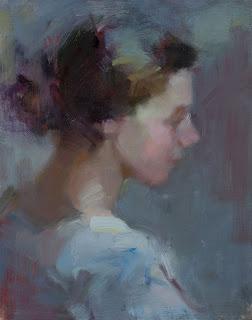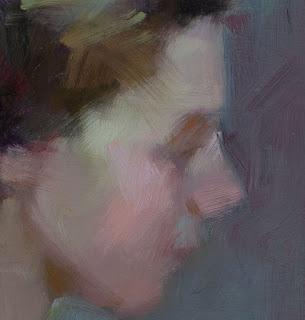
Girl in Pink and Grey
14 x 11
Photos give us the idea that an entire scene can be in crisp focus, no matter how broad, but that's only true if you're a camera. Humans don't see like that. What we see is soft edges with only a tiny fraction of sharpness - maybe 2% of our visual field. Maybe 1%. It's actually surprising to realize how indistinct our visual experience is. Too often, though, we forget this when we paint, especially if we're painting from photos. We end up creating painted photos instead of paintings that show our view of the world.


The piece above shows how few hard edges you need to make a believable painting. I've clustered the edges in the focal area near the eye and the upper part of the face while diminishing the edges of forms as they get further away from the focal point. The back of the head is just a scribble of tone suggesting upswept hair. This isn't only a stylistic choice, it's realistic. We can't see detail in a hairdo while holding a face in the center of our visual field. This painting still has far more sharp edges than my eye sees, but the edges that I choose to crisp up are the ones that help move the viewer's eye through the piece. They're compositional elements, selected for their usefulness, not out of a sense of doing justice to the photo reference.
My biggest advice to painters is always to trust their eyes, and then to manipulate the information that their eyes give them to suit their purposes.
Happy painting!
*If you'd like to receive my blog in your inbox, please enter your address in the box on the right that says "follow by email".

